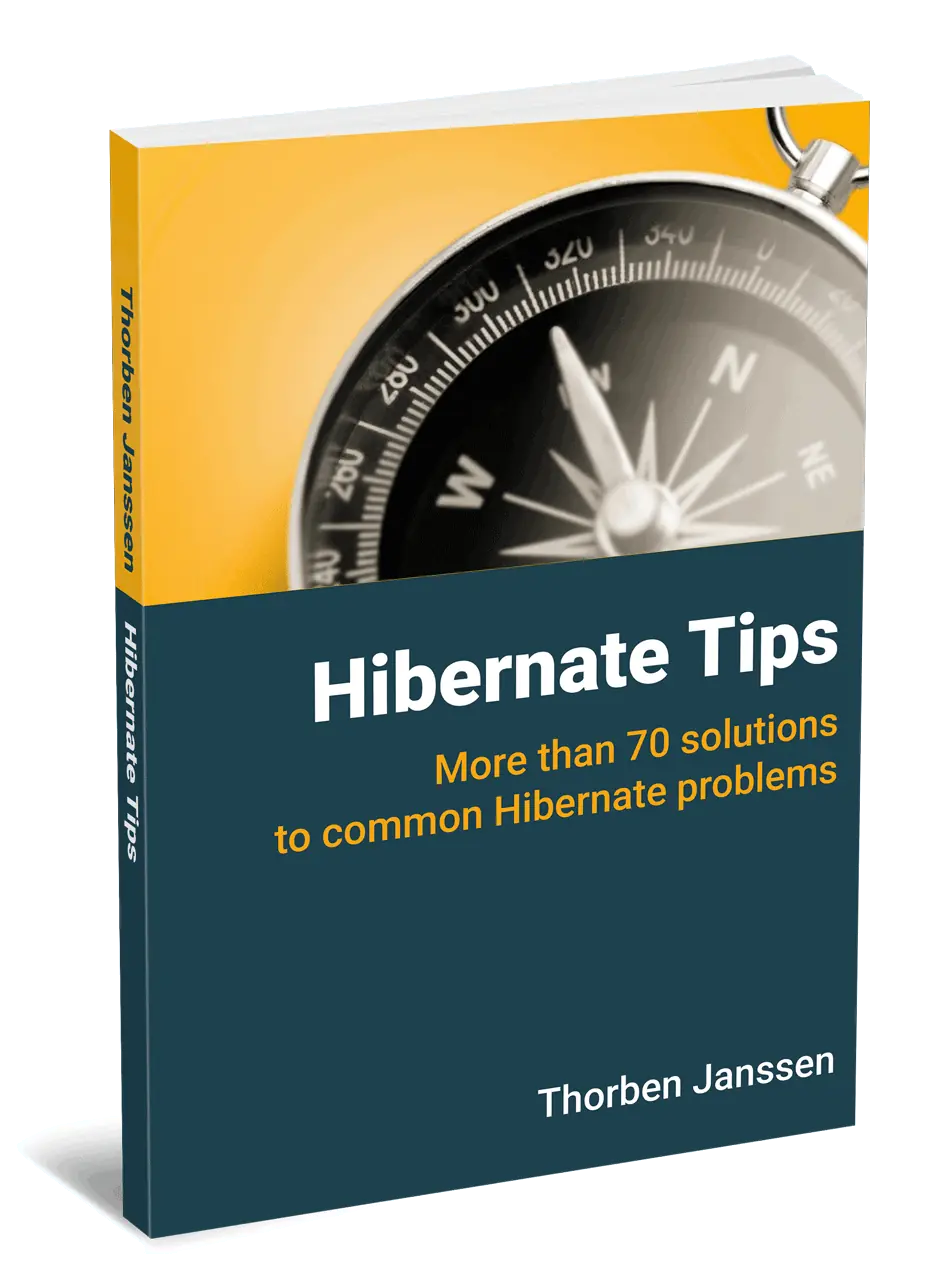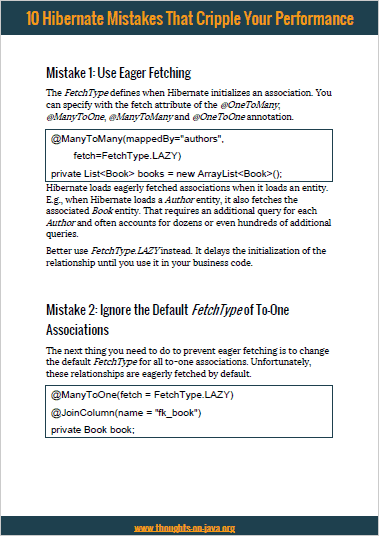Hibernate Tips: How to fetch associations in batches
Take your skills to the next level!
The Persistence Hub is the place to be for every Java developer. It gives you access to all my premium video courses, monthly Java Persistence News, monthly coding problems, and regular expert sessions.
Hibernate Tips is a series of posts in which I describe a quick and easy solution for common Hibernate questions. If you have a question you like me to answer, please leave a comment below.
Question:
I need to initialize the associations of multiple entities. Is there a way to tell Hibernate to fetch the associated entities for multiple entities?
Solution:
The best way to load associated entities is to use a JOIN FETCH clause or a @NamedEntityGraph. These tells Hibernate to fetch the associated entities with the initial query. So, Hibernate joins the mapped database tables and loads all the data with only 1 query.
If you can’t use these options or if the created cartesian product gets too big, you can also annotate the association with Hibernate’s @BatchSize annotation. It tells Hibernate to initialize the relationships of multiple Author entities in a batch.
@Entity
public class Author {
@ManyToMany(mappedBy="authors")
@BatchSize(size = 5)
private List<Book> books = new ArrayList<Book>();
...
}
When you use this mapping in the following test case, Hibernate will initialize the books association for up to 5 Author entities in one batch.
EntityManager em = emf.createEntityManager();
em.getTransaction().begin();
List<Author> authors = em.createQuery("SELECT a FROM Author a", Author.class).getResultList();
for (Author a : authors) {
log.info("Author with id "+a.getId());
a.getBooks().size();
}
em.getTransaction().commit();
em.close();
It executes 1 query to load the 6 Author entities that exist in my test database. Then the test case starts to iterate through the List of Author entities. When it calls the getBooks() method of the first Author entity, Hibernate initializes the association of the first 5 Author entities returned by the previous query. As you can see in the log output, it uses an IN clause to efficiently reference the primary keys of the 5 entities. And when the test case calls the getBooks() method of the 6th and last Author entity, Hibernate performs another query to fetch the associated Book entities.
18:23:34,974 DEBUG [org.hibernate.SQL] -
select
author0_.id as id1_0_,
author0_.firstName as firstNam2_0_,
author0_.lastName as lastName3_0_,
author0_.version as version4_0_
from
Author author0_
18:23:35,019 INFO [org.thoughts.on.java.model.TestBatchSize] - Author with id 1
18:23:35,024 DEBUG [org.hibernate.SQL] -
select
books0_.authorId as authorId2_2_2_,
books0_.bookId as bookId1_2_2_,
book1_.id as id1_1_0_,
book1_.publisherid as publishe5_1_0_,
book1_.publishingDate as publishi2_1_0_,
book1_.title as title3_1_0_,
book1_.version as version4_1_0_,
publisher2_.id as id1_3_1_,
publisher2_.name as name2_3_1_,
publisher2_.version as version3_3_1_
from
BookAuthor books0_
inner join
Book book1_
on books0_.bookId=book1_.id
left outer join
Publisher publisher2_
on book1_.publisherid=publisher2_.id
where
books0_.authorId in (
?, ?, ?, ?, ?
)
18:23:35,040 INFO [org.thoughts.on.java.model.TestBatchSize] - Author with id 2
18:23:35,041 INFO [org.thoughts.on.java.model.TestBatchSize] - Author with id 3
18:23:35,041 INFO [org.thoughts.on.java.model.TestBatchSize] - Author with id 4
18:23:35,041 INFO [org.thoughts.on.java.model.TestBatchSize] - Author with id 5
18:23:35,041 INFO [org.thoughts.on.java.model.TestBatchSize] - Author with id 6
18:23:35,041 DEBUG [org.hibernate.SQL] -
select
books0_.authorId as authorId2_2_2_,
books0_.bookId as bookId1_2_2_,
book1_.id as id1_1_0_,
book1_.publisherid as publishe5_1_0_,
book1_.publishingDate as publishi2_1_0_,
book1_.title as title3_1_0_,
book1_.version as version4_1_0_,
publisher2_.id as id1_3_1_,
publisher2_.name as name2_3_1_,
publisher2_.version as version3_3_1_
from
BookAuthor books0_
inner join
Book book1_
on books0_.bookId=book1_.id
left outer join
Publisher publisher2_
on book1_.publisherid=publisher2_.id
where
books0_.authorId=?
Learn More
Fetching the associated entities in batches is a lot better than loading them one by one. But in most situations, it would be even better to initialize the association with the query that loads the entity. JPA and Hibernate provide different options to do that. I show you 5 of them in 5 ways to initialize lazy associations and when to use them.
Hibernate Tips Book

Get more recipes like this one in my new book Hibernate Tips: More than 70 solutions to common Hibernate problems.
It gives you more than 70 ready-to-use recipes for topics like basic and advanced mappings, logging, Java 8 support, caching, and statically and dynamically defined queries.


What if i want the next 5 batches?
You can’t fetch multiple batches at once. You have to iterate through the list and whenever necessary, Hibernate automatically fetches the next batch.